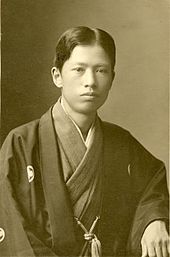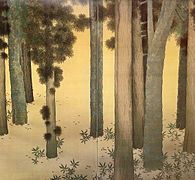Hishida Shunso
Hishida Shunsō ( Japanese 菱 田 春草 , real name Mioji ( 三 男 治 ); born September 21, 1874 in Iida Prefecture Nagano - September 16, 1911 ) was a Japanese painter of the Nihonga direction in the Meiji period .
life and work
Hishida was the third son of a samurai who belonged to the Iida branch of the Hori clan . In 1889 he went to Tokyo and began training in traditional Japanese painting from the Kanō School under Yūki Masaaki (1834-1904), then switched to the "Tokyo Art Academy" in 1890 ( Tōkyō bijutsu gakkō , today Tōkyō Geijutsu Daigaku ). Spurred on by Okakura Kakuzō , the head of the school, Hashimoto Gahō and fellow students Yokoyama Taikan and Shimomura Kanzan , Hishida joined the Nihonga school . In 1895 he finished his training with the painting "Widow and Child" ( 寡婦 と 孤 児 , Kafu to koji ).
In 1886, Hishida was employed at the art school for teaching in the preparatory class. He participated in the establishment of the "Society for Japanese Painting" ( 日本 絵 画 協会 , Nihon kaiga kyōkai ), in the framework of which pictures of him were exhibited such as "Landscape in the four seasons" ( 四季 山水 , Shiki sansui ), "Flowers and a smile ”( 拈 華 微笑 , Nenge bishō ),“ reflection in the water ”( 水鏡 , Mizukagami ). Hishida also copied early paintings for the Imperial Museum during this time. When in 1898 Okakura angrily left the art school and founded the private art school Nihon bijutsu-in ( 日本 美術 院 ) in Tokyo together with Hashimoto, Yokoyama and Shimomura , Hishida followed him.
In 1903 Hishida visited India with Yokoyama, where both exhibited pictures in Calcutta. In 1904 he traveled to the USA under the direction of Okakura, together with Yokoyama and other painters. The group exhibited paintings in New York in April and in Boston in November. In 1905, Hishida and Yokoyama exhibited again in New York and then in Washington before traveling on to Europe in April. In April they went to Europe, where the two exhibited in London. They then visited Germany, France and Italy before returning to Japan in August.
When the Nihon bijutsu-in had to move to Izura in Ibaraki Prefecture in 1906 for economic reasons , Hishida went there too. In search of his style he worked with painters of the 17th and 18th centuries, such as Tawaraya Sōtatsu and Ogata Kōrin . From them he took over the decorative component, which he combined with shadow formation in the western style.
When the Ministry of Culture started organizing an annual exhibition in 1907, called Colorful for short, Hishida was represented in the Department of Japanese Painting, for example in 1907 with the painting "Patriarch Kenshu" ( 賢首 菩薩 , Kenshu bosatsu ), in 1909 with one of his adjustable screens -Couples “Fallendes Laub” ( 落葉 , Ochiba ), 1910 with “Black Cat” ( 黒 き 猫 , Kuroki neko ). The “Black Cat”, which was also issued as a postage stamp by the Japanese Post, is one of the icons of more recent domestic painting in Japan.
Hishida, handicapped by increasing blindness caused by a kidney infection since 1908, died after three years, not even 37 years old.
photos
Remarks
- ↑ Important cultural asset.
- ↑ Patriarch Kenshu is also known under the name 法 藏 , Japanese Hōzō, Chinese Fazang .
- ↑ This pair of display screens is registered as an important cultural asset , not a similar pair from the same year on which the two little trees are reversed.
- ↑ First screen of a total of five with the same title.
literature
- Hosono, Masanobu, et al. a .: Hishida Shunso . Asahi Kurabu Bessatsu Nihon-hen 51, Bijutsu tokushu. 1987
- Tazawa Yutaka: Biographical Dictionary of Japanese Art . Kodansha International, 1981, ISBN 0-87011-488-3 .
- Laurance P. Roberts: A Dictionary of Japanese Artists. Weatherhill, 1976, ISBN 0-8348-0113-2 .
- Hishida, Mioji . In: Hans Vollmer (Hrsg.): General Lexicon of Fine Artists of the XX. Century. tape 2 : E-J . EA Seemann, Leipzig 1955, p. 451 .
Web links
| personal data | |
|---|---|
| SURNAME | Hishida, Shunso |
| ALTERNATIVE NAMES | 菱 田 春草 (Japanese, stage name); Hishida Mioji (real name); 菱 田 三 男 治 (Japanese, real name) |
| BRIEF DESCRIPTION | Japanese painter |
| DATE OF BIRTH | September 21, 1874 |
| PLACE OF BIRTH | Iida |
| DATE OF DEATH | September 16, 1911 |






